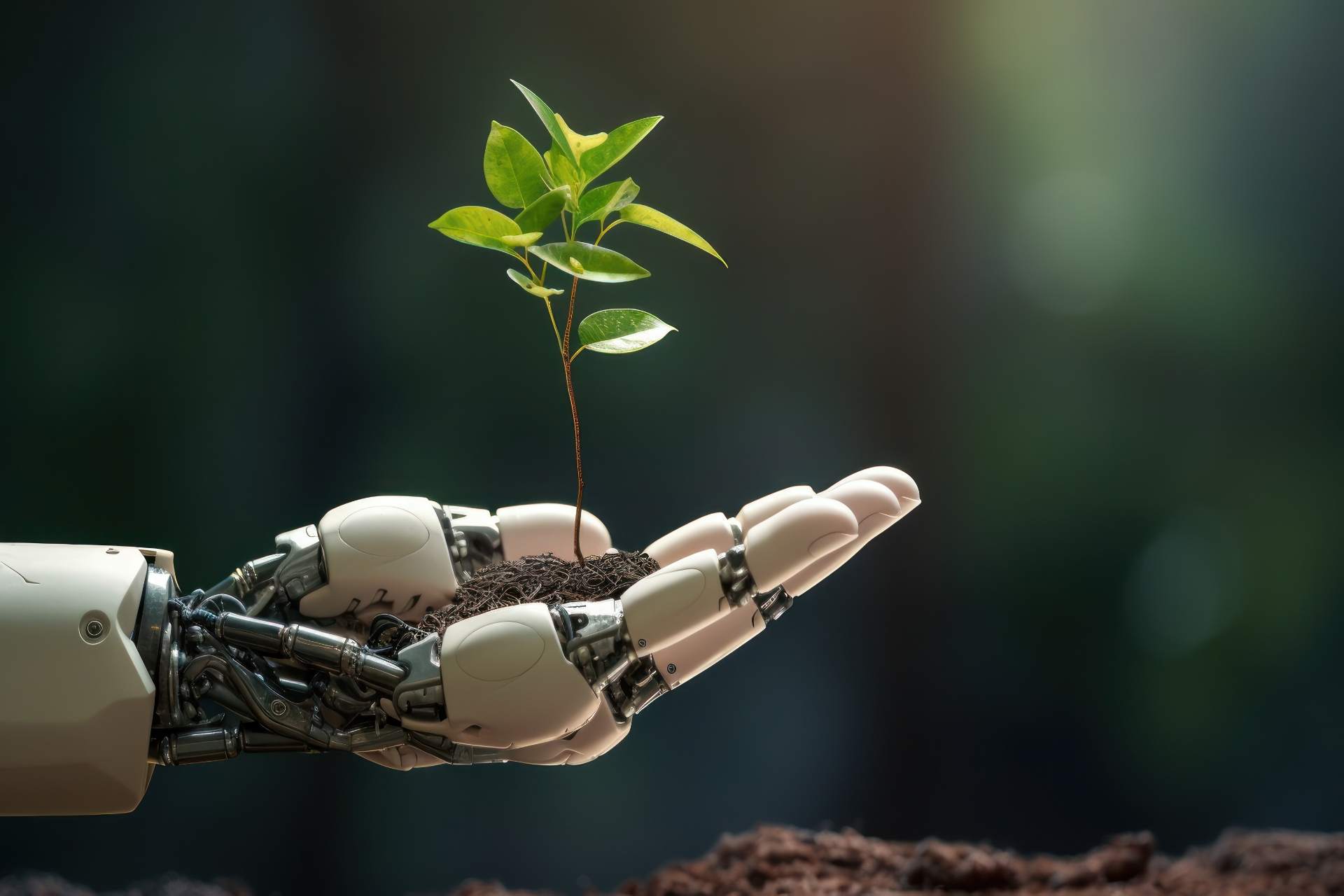Technological development and climate change: the role of AI
Artificial intelligence (AI) is quickly changing the way we work, live and face the challenges of contemporary society. Some good examples already come from its successful application into the quality improvement of healthcare, the optimization of business processes and resource management, and the reduction of production wastes. This is the era of the AI models and, if properly trained, they can be a new important companion for humans to best handle climate change, thus minimize polluting emissions, reduce waste and cut down the negative environmental impact.
Therefore, artificial intelligence can help people and companies to approach the consume of energy more intelligently and reduce greenhouse gas emissions, fully joining and participating in the activating for climate change.
The climate crisis is surely one of the greatest challenges of our time, with a significant impact on our lives already. Global warming is causing extreme weather phenomena more and more frequently, such as heat waves and droughts, but also increasingly intense storms. This is not just a question of weather conditions, but above all a serious threat for the survival of several animal and plant species, for example with the raise of sea levels and the consequent destruction of whole natural habitats and loss of biodiversity.
In addition to this, there are also many social, economic and political factors that might be significantly negative and impactful for the environment, like mass migrations and conflicts due to the shortage of food and water, the impoverishment of the most vulnerable communities in developing countries, the growing gap between richer and poorer countries, the increase in social inequalities, the spread of new diseases directly related to air pollution (especially respiratory and cardiovascular), and the loss of workforce in agriculture and fishing, the most affected sectors by climate change.
It’s really time to seriously take action and prevent potential irreversible damage, preserving the balance of the planet and guaranteeing a sustainable future for future generations. To achieve this key mission for humanity, it’s essential to leverage the power of new technologies, like artificial intelligence, to hinder and mitigate climate change undertaking the path towards environmental sustainability.
How can artificial intelligence help hinder climate change?
According to data from the State of Science Index 2023, the annual survey carried out by 3M to check the perception of science at a global level, the majority of respondents within the 17 countries involved in the research (US, Canada, Mexico, Brazil, UK, France, Germany, Spain, Thailand, Taiwan, Italy, India, China, South Korea, Japan, Hong Kong, Australia) feel confident to science and technology and believe in the great potential of AI in building a more sustainable future, generating a positive impact on daily life as well.
According to the UN analysis, artificial intelligence can help reduce environmental impact and promote sustainability in several ways. Let’s check them out:
- Weather forecast
According to World Meteorological Organization (WMO), AI-based technologies provide disruptive capabilities to process huge volumes of data, extract useful and detailed insights and improve the predictive models. This means increasing the possibility to predict potential extreme weather events, enabling authorities to take security measures in advance and mitigate all the consequent damages, which is especially saving lives and reducing economic losses. The use of more accurate data can change the impact that natural disasters have on people and economies.
A useful example that shows the key role of technology is the MyAnga application that helps shepherds in Kenya prepare above all for drought events: data from worldwide weather stations and satellites are easily and quickly made available to herders via mobile phones, so they can take proper actions to be ready for when the weather phenomenon occurs, managing livestock and saving time searching for green pastures.
- Disaster prevention
As extreme weather events occur with greater frequency and intensity, artificial intelligence can help communities around the world better prepare for climate disasters and reduce their impacts. In fact, AI-based tools identify high-risk areas and better shape local and national response plans: for example, in the case of landslide-prone areas AI is capable of mapping the territory in detail, supporting authorities to plan and implement sustainable development measures, reduce risks and ensure the safety of people and things.
According to WMO, which operates a disaster risk reduction program and early warning system serving countries and humanitarian agencies, AI is already having an impactful role in the improvement of accuracy of weather forecasts and reduction of disaster risks. AI is also a fundamental part of the project Early Warnings for All, the plan aiming to protect all Earth’s inhabitants from weather disasters through early warning systems by the end of 2027.
- Pollution tracking
Susceptibility mapping based on AI can support local governments make decisions to improve public health and urban resilience. Furthermore, this technology can effectively enhance urban planning and traffic, as well as waste management, thus making cities more sustainable and livable.
- Carbon neutrality
The world’s approach to carbon neutrality could be revolutionized by AI, introducing an era of intelligent sustainability on a global scale as it becomes increasingly urgent to find solution to hinder (and prevent) Earth’s warming.
To minimize the environmental impact and maximize the resources consumption efficiency, properly train of AI algorithms can play a key role in the mission of achieving the global goal of clean and accessible energy for all by 2030 (SDG-7), with the optimization of networks and renewable sources. Another relevant option is given by AI-powered predictive maintenance, which can help reduce downtime in energy production and so cut down the planet’s carbon footprint.
- Fast fashion
Fashion is a sector with a negative record in terms of high emissions and environmental impact, a $2.4 trillion global industry employing around 300 million people across its value chain (many of whom are women), and expected to scale up and grow more and more in future.
According to the UN Alliance for Sustainable Fashion, given its massive size and global reach, unsustainable practices within the fashion industry have a deeply major impact on social and environmental development indicators. A tough situation which, without significant changes in the production processes and consumption patterns, is going to get worse with the increase of pollution, emissions and wastes. And so, the increase of this industry’s social and environmental costs.
This is where artificial intelligence can save the fashion industry, with the adoption of AI-driven innovation to optimize supply chains, reduce waste, monitor resource consumption, promote green transition and implement sustainable manufacturing processes based on the acceleration on renewable energy and recycling.
Fast food
Agriculture, breed farming and food industry represent other relevant high-emitting sectors, responsible for 22% of global greenhouse gas emissions.
From large companies to small farmers, everyone faces extreme weather phenomena like aggressive and massive storms, water shortage or land degradation. AI can change this, giving help to optimize work, reduce waste and minimize the environmental impact of food production chains.
AI-driven smart grids and tools can balance supply and demand, facilitating the integration of renewable energy systems and reducing dependence on fossil fuels: this is going to be crucially important for building climate resilient, efficient and sustainable agri-food systems with proper adaptability to climate change challenges.
Carbon footprint of AI: the environmental costs of artificial intelligence
As the use of artificial intelligence grows it appears clear that this powerful technology is already improving our lives, increasing productivity and tackling the most pressing challenges of this age like climate change. But, it is important to consider its footprint carbon, too.
In fact, as happens with any other technology that requires large amounts of energy, AI has its own environmental impact and generates a significant carbon footprint. From the huge amounts of data needed to train the models by feeding them with new and improved information, to the energy resources that they need to operate, the overall carbon footprint of AI is quite difficult to measure. However, clearly this process is environmentally costly.
First of all, the costs for the production of hardware (devices enabling AI like computers, smartphones, smartwatches, etc.), considering above all that it requires the processing of raw materials which generate pollution to be extracted and worked. Then, when hardware is ready, for what concerns software developers need considerable power consumption for the training of AI models, which translates into more wastes.
For example, in an interview with The Markup, computer engineer Shaolei Ren revealed that training GPT-3 in Microsoft’s cutting-edge US data centers can consume 700,000 liters of clean fresh water, which is enough to produce 370 BMW cars or 320 Tesla electric vehicles. And if the training had been carried out in Microsoft’s data centers in Asia, water consumption would have probably tripled.
Considering what users can do, instead (for example having a conversation with the ChatGPT software), the study shows this very popular tool needs approximately 500 ml of water to generate a short conversation made of 20 to 50 questions and answers, depending especially on when and where the model is used. Given ChatGPT’s huge user base around the world, the total water footprint generated can be massive and this is not good for the health of our planet.








